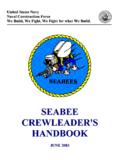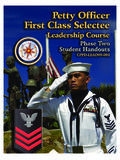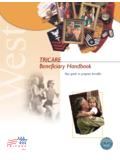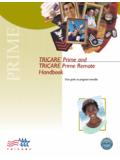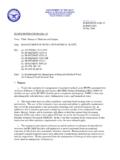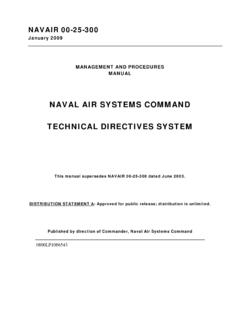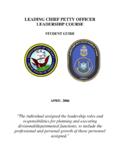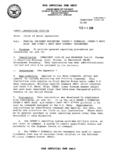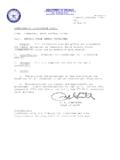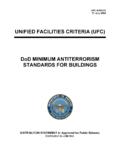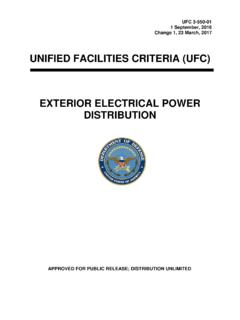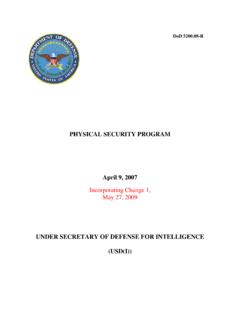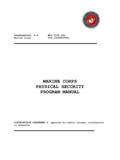Transcription of CNIC INSTRUCTION 5530 - NAVY BMR
1 DEPARTM ENT OF THE NAVY COMMANDER, NAVY INSTALLATIONS COMMAND 716 SICARD STREET, SE, SUITE 1000 WASHINGTON NAVY YARD, DC 20374-5140 CNICINST N3 JUL 7 2011 CNIC INSTRUCTION From: Commander, Navy Installations Command Subj: CNIC ASHORE PROTECTION PROGRAM Ref: (a) OPNAVINST , Navy Physical Security and Law Enforcement Program, 28 Jan 09 (b) OPNAVINST , Navy Antiterrorism Program, 26 May 09 (c) OPNAVINST , Required Operational Capability Levels for Navy Installations and Facilities, 29 Oct 08 (d) DoDI , DoD Antiterrorism Standards, 02 Oct 06 (e) DoDD , DoD Antiterrorism (AT) Program, 18 Aug 03 (certified current 13 Dec 07) (f) CJCS INSTRUCTION , Standing Rules of Engagement/Standing Rules for the Use of Force SROE/SRUF for Forces, 13 Jun 05 (g) NTTP , Law Enforcement and Physical Security for Navy Installations, 29 Jan 09 (h)
2 NTTP , Antiterrorism, Sep 06 (i) 50 , Section 797, Jan 03 (j) SECNAV , DON Information Requirements (Reports) Manual, 01 Dec 05 (k) SECNAV , DON Records Management Manual, 16 Nov 07 Encl: (1) CNIC ASHORE PROTECTION REQUIREMENTS AND STANDARDS 1. Purpose. The purpose of this INSTRUCTION is to implement responsibilities, set forth best practices, and provide requirements and direction for the protection of people and assets throughout CNIC as directed in references (a) through (f). 2. Cancellation a. CNICINST dated 11 December 2007: Taxicab, Limousine and Shuttle Access on Navy Installations CNICINST JUL 7 2011 2 b.
3 CNICINST dated 29 February 2008: Rental Car Access on Navy Installations c. CNICINST dated 28 June 2006: Online DoD Decal Renewal System d. CNICINST dated 2 June 2008: Auxiliary Security Force e. CNICINST dated 10 Dec 2006: Antiterrorism and Emergency Preparedness Consequence Management Required Operational Levels For Navy Installations f. CNIC Notice 5530 15 dated Oct 2010: Policy Regarding Resourcing, Sustainment and Maintenance of Intrusion Detection Systems (IDS) 3. Background a. This INSTRUCTION provides a common organizational framework for Navy Security Forces (NSF) during routine and emergency response activities between Navy Regions, Installations, and ships.
4 B. The CNIC Ashore Protection Program incorporates a systems approach to integrating antiterrorism (AT), physical security (PS), and law enforcement (LE) capabilities for the prevention or mitigation of hostile actions against personnel, resources, and facilities, both afloat and ashore. This program serves as the principal process for the integration and implementation of the AT, PS, and LE requirements, standards and guidelines directed by references (a) through (f). 4. Policy a. This INSTRUCTION applies to all Navy military personnel, civilian employees, contractors, facilities and non-Navy organizations physically located on or aligned to Navy-controlled installations worldwide.
5 B. This INSTRUCTION does not directly apply to afloat units, Navy Nuclear Security, personnel security, information systems security, or chemical agent security. c. Where this INSTRUCTION conflicts with the Geographic Combatant Commander (GCC) or assigned Operational Commander CNICINST JUL 7 2011 3 ( Naval Component Commander (NCC)) protection requirements, the GCC's/NCC s requirements take precedence. d. Deviation from the policy and standards in this INSTRUCTION must be documented in the appropriate planning procedures and implementing guidance. A request for a waiver or exception must be submitted in accordance with (IAW) paragraph 0412 of enclosure (1).
6 E. The policy language used in this INSTRUCTION includes: (1) Policies that include the words shall, will, or must are directive in nature and provide standards, measures or actions. An inability to meet these requirements necessitates a request for a waiver or exception. (2) Recommended procedures include the word "should". These recommendations provide a framework that support the mandatory polices. (3) Enabling procedures include the words "may or can". These are not requirements, but are possible actions or measures to take at the discretion of the responsible party. (4) Prohibitive procedures include the words "shall not, will not, or may not" if the action is prohibited without prior authorization.
7 Actions that are advised against but left to the responsible party's judgment include the words should not f. Union notification and subsequent bargaining requirements must be satisfied prior to implementation of this INSTRUCTION . Regional program managers will advise CNIC Codes N13 and N3AT when notification has been accomplished, and provide periodic status of bargaining until completed. g. This INSTRUCTION amplifies the AT, PS and LE aspects of Protection, pillars which complement, integrate with, and support the three Protection core lines of effort (see Figure 1). The primary area of focus for this document is FP. The prioritization of implementing the pillars must be based on each Commander's risk management process.
8 In general, the AT mission shall be treated as the effort of first importance as it ensures the availability of Navy assets for war-fighting missions. CNICINST JUL 7 2011 4 Figure 1. Protection Community (Source JP ) 5. Responsibilities a. CNIC N3AT is responsible for: (1) Identifying the resources programmed to implement and maintain the Protection Program as part of the planning, programming, and budgeting system process. (2) Performing Protection Program planning and resourcing as outlined in reference (b). (3) Providing unified and consistent protection procedures, standards of service, and practices for effective and efficient management of installation support.
9 (4) Developing, managing, and distributing an Ashore NSF Table of Allowance (TOA). b. Region Commanders (REGCOMs) are responsible for: (1) Promulgating guidance for Installation Commanding Officers (COs) to establish security measures in accordance with regional guidance and higher headquarters directives. CNICINST JUL 7 2011 5 (2) Exercising geographical area of responsibility command and control and developing and implementing a comprehensive protection plan designed to accomplish all requirements or standards contained in this document. (3) Assessing installations/facilities to ensure they develop, maintain and implement protection plans and programs.
10 Examples include but are not limited to: AT Plan, Physical Security Program, Law Enforcement Program, General Public Visitation, and Standard Operating Procedures. c. Installation Commanding Officers (COs) are responsible for: (1) Providing security for resources, facilities, mission critical assets, CIP, and personnel under their authority (including family members and civilians when applicable) and control consistent with threat, risk, vulnerability, criticality, assigned roles, missions, and resources. (2) Providing awareness information and educational materials to help service members, civilian employees, and contractor personnel prepare themselves and their family members to reduce their individual risk and vulnerability to terrorism and criminal activity.
